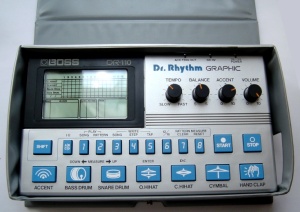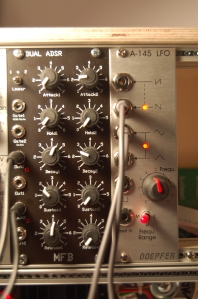The Monomachine is what I call THE unortodox synth concept in an alluminium box.

Elektron MonoMachine SFX60
Everybody interested in innovative music machines knows the philosophy of the Elektrons, an easy and intuitive approach to manipulation/creation of sounds and sequencing, multi synthesis to have a extremely versatile palette of sound at your fingertips, a really good support from tutorials to fresh new O.S. often released to get more power from your machine.
The Monomachhine is structured as six digital monosynth with efx, arpeggiator and a 64 step sequencer track.
Every “monosynth” can be a synth , a efx processor or an audio in track (to process external signals).
So this box can generate, process and manipulate audio material all together in a really easy way.
Let’s get deeper into the machine…
MULTI SYNTHESIS
Every track can use one of the machine:
- GND (gnd/sine/noise generator)
- SuperWave (kind of virtual analog machine)
- DigiWave (wavetable synthesis and a drum machine 12bit sample based)
- FM+ (kind of Frequency Modulation synthesis)
- SID (emulation of the C64 synth chip used even in the Elektron Sidstation)
- VO (vocal synth)
- EFX (a processing machine for internal or external sounds)
You can build a kit with a different machine on every track , so you can have a very versatile sonic palette of sound .
Every machine can do different things and even the oddest one (as the VO) can be really useful and amazing , when you use them with creativity.
The thing to keep in mind with the Mono is that it’s not a standard synth, it’s a Monomomachine!
Machines , usually, have only ONE oscillator, and this can be considered a great limitation, but it isn’t so.
If you want the machine to make detuned trance leads you have only to choose the Superwave SAW machine and turn up the unison and work with the detune and you will get a “supersaw” sound in few seconds…
If you’re searching for bells, the EFM machines are the best, choose the parallel and play with the knobs, you ‘ll get a bell sound as soon as you turn those knobs.
Considering the “Generator” part of the synth (oscillators machines) the MonoMachine is really versatile and easy but even a synth of its own kind, as for the other parts as filters, envelopes and modulations…
The filter section is composed by a really particular filter that act as a multimode.
You have:
- Base freq
- Width
- Highpass Q
- Lowpass Q
- Base env amount (bofs)
- Width env amount (wofs)
- Attack
- Decay
In use I can say that it can cut the low freq turning up the base freq(highpass), cut the high freq turning down the width (lowpass), or can be a band pass using the base to chose the”freq” and the width choosing the “band”.
All in all is a very versatile filter that sound “elektron”, not a moog o roland replica/emulation, but it’s really rounded and acid, when you turn up the Qs, but it can even select the frequencies in a clinical way just to shape a minimal sound.
The filter does not have an auto normalization/headroom, this can give it that carachter, if you want a clean resonance you ha to turn down the “volume” or “distortion”(headroom) in the AMP page.
The AMP page is where we have the amp and volume settings and the particular AHDR env.
The reason this particular env was chosen by Elektron is because the Monomachine was born as a sequencer based machine so, the holod can take advantage of the sequencer way of thinking.
Apart from HOLD the other things are quite standard, as volume, pan, portamento.
The only parameter that really shape the armonics of the sound is the DISTORTION, that is the headroom.
A higher distortion doesn’t “grunge” the sound or add noisy harmonics, but saturate the signal making higher harmonics less evident getting a darker sound.
The EFX page is one of my favorite in the MonoMachine, they are not the classic delay /reverb, but Sample Rate Reduction, a parametric EQ and a delay.
As everything can be automatized with the “parameter locks” (this is the name in elektrons for the MOTION SEQ in the Korgs) you can have awesome results using parameter locks on SRR or delay parameters…
Last but not least the LFOs.
Lfos are the key to the monomachine together with the parameter locks, because there are 3 of them and everyone can modulate every parameter of the synth generator.
Imagine a modulated delay with a oscillating SRR… amazing!
to be continued…
stay tuned!






